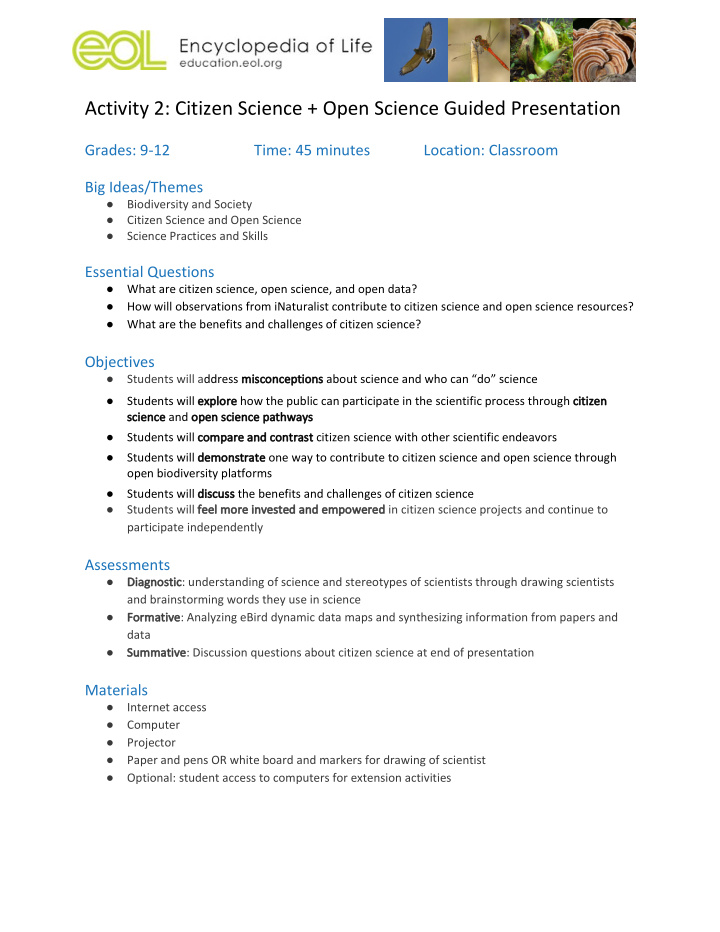



Activity 2: Citizen Science + Open Science Guided Presentation Grades: 9-12 Time: 45 minutes Location: Classroom Big Ideas/Themes ● Biodiversity and Society ● Citizen Science and Open Science ● Science Practices and Skills Essential Questions ● What are citizen science, open science, and open data? ● How will observations from iNaturalist contribute to citizen science and open science resources? ● What are the benefits and challenges of citizen science? Objectives ● Students will a ddress misconceptions about science and who can “do” science ● Students will explore how the public can participate in the scientific process through citizen science and open science pathways ● Students will compare and contrast citizen science with other scientific endeavors ● Students will demonstrate one way to contribute to citizen science and open science through open biodiversity platforms ● Students will discuss the benefits and challenges of citizen science ● Students will feel more invested and empowered in citizen science projects and continue to participate independently Assessments ● Diagnostic : understanding of science and stereotypes of scientists through drawing scientists and brainstorming words they use in science ● Formative : Analyzing eBird dynamic data maps and synthesizing information from papers and data ● Summative : Discussion questions about citizen science at end of presentation Materials ● Internet access ● Computer ● Projector ● Paper and pens OR white board and markers for drawing of scientist ● Optional: student access to computers for extension activities
Directions Preparation + Presentation This activity can be facilitated in two ways: ● Classroom: teacher can present in class to students, then lead discussion ● Flipped-style: students can watch presentation at home and teacher can lead discussion in class This presentation is available in two formats**: ● Google Slides Presentation (on web, view only) ● Microsoft PowerPoint Presentation (download via Google Drive) **Note: if you do not have access to Google Drive, please contact education@eol.org and we will email you a PowerPoint directly. If presenting in class, set up presentation on a screen. Notes for each slide can be found in the “notes” section at the bottom of the slide. In “Present” mode in PowerPoint, you should be able to see the notes as you lead the presentation on computer (students will not be able to see the notes in “Present” mode). If you use the presentation is recommended to review it at least once before you present, as there are moments that ask students to draw or discuss concepts, and you may find places you want to modify, add information, or go out to a website. There are additional resources below for potential extensions: ● reading scientific papers that include data collected by citizen scientists ● an optional assignment to join a citizen science project of their choice on Zooniverse ● watching EOL video podcasts about about monarch butterfly and moth citizen science projects Extensions Go onto Scistarter.com and Zooniverse.org and show students some of the interesting projects going on. What are two or three projects that students are interested in doing outside of school? If you choose to assess this, ask students to take a screenshot documenting their participation in the project and write about their experience. In the next lesson, we’ll explore the features of iNaturalist and learn how to make great observations to document biodiversity. Think of some questions scientists might be able to address with data from iNaturalist. Additional Resources ● Using SciStarter in the Classroom - examples of suitable projects for high school students https://scistarter.com/page/Educators.html ● Encyclopedia of Life Citizen Science podcasts http://eol.org/info/podcasts_citsci
Scholarly articles about biodiversity citizen science projects including iNaturalist: Chandler, M., See, L., Copas, K., Bonde, A. M., López, B. C., Danielsen, F., ... & Rosemartin, A. (2016). Contribution of citizen science towards international biodiversity monitoring. Biological Conservation . http://www.sciencedirect.com/science/article/pii/S0006320716303639 He, Y., & Wiggins, A. (2015, October). Community-as-a-Service: Data Validation in Citizen Science. METHOD 2015 workshop. http://drum.lib.umd.edu/handle/1903/17450 Jacobs, C., & Zipf, A. (2017). Completeness of citizen science biodiversity data from a volunteered geographic information perspective. Geo-spatial Information Science , 1-11. http://www.tandfonline.com/doi/full/10.1080/10095020.2017.1288424 La Sorte, F. A., Fink, D., Hochachka, W. M., & Kelling, S. (2016, January). Convergence of broad-scale migration strategies in terrestrial birds. In Proc. R. Soc. B (Vol. 283, No. 1823, p. 20152588). The Royal Society. http://rspb.royalsocietypublishing.org/content/283/1823/20152588 (paper published from millions of eBird occurrence data points)
Next Generation Science Standards Performance Expectations ● HS-LS2-2. Use mathematical representations to support and revise explanations based on evidence about factors affecting biodiversity and populations in ecosystems of different scales. ● HS-LS2-6. Evaluate the claims, evidence, and reasoning that the complex interactions in ecosystems maintain relatively consistent numbers and types of organisms in stable conditions, but changing conditions may result in a new ecosystem. ● HS-ESS3-3. Create a computational simulation to illustrate the relationships among management of natural resources, the sustainability of human populations, and biodiversity. Science and Engineering Practices ● Asking Questions and Defining Problems ● Analyzing and interpreting Data ● Constructing Explanations and Designing Solutions ● Engaging in Argument from Evidence ● Obtaining, Evaluating and Communicating Information NGSS Nature Of Science Principles (Appendix H) ● Scientific Investigations Use a Variety of Methods ● Scientific Knowledge is Based on Empirical Evidence ● Scientific Knowledge is Open to Revision in Light of New Evidence ● Scientific Models, Laws, Mechanisms, and Theories Explain Natural Phenomena ● Science is a Way of Knowing ● Scientific Knowledge Assumes an Order and Consistency in Natural Systems ● Science is a Human Endeavor ● Science Addresses Questions About the Natural and Material World
Recommend
More recommend